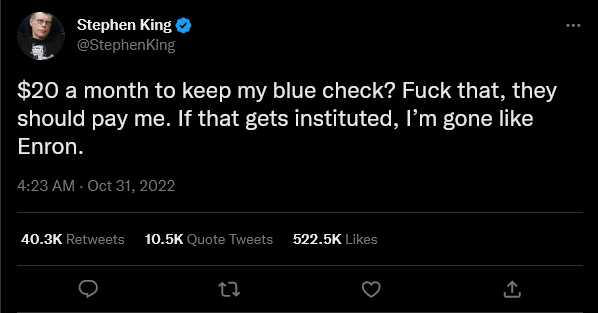[G]Press Holiday Special
Twitterati in Disarray; Photos: All the Leaves are Brown and the Sky is Gray
In this Issue:
Season’s Greetings and 2022 at [G]Press in Review
Twitterati in Disarray: Twitter is for Messaging, not Discussion [because it is a button factory]
Poem for 2022.12.09
Out And About Photo(s) for 2022.12.09
Season’s Greetings
Thank you for reading, especially those of you that have subscribed in any way. Below is a glimpse into some [G]Press reader habits. As well as a piece regarding Twitter, which seemed like a relevant time to talk about it, and some out and about photos collected since last issue.
Wishing you all the best, and a Happy New Year!
Regards,
Garrett
2022 at [G]Press in Review
Apart from this issue, there were 13 others that came out this year. As of today (2022.12.09), the most popular is the 2022.08.19 issue with the headline || subheadline:
[Relatedly, the 2022.09.02 issue focusing on a timeline of the events leading up to the search ranked number 5 overall.]
The second most popular issue of the year came the first week of August and heavily featured crows:
Third most popular is a US Supreme Court Dobbs focused issue, which just edged out the 2022.09.16 UAP study and review of Nope issue:
For reference, the About page has a category breakdown with links to all individual pieces of writing in the issues. The current categories are January 6th Committee, SCOTUS, Discovery/Misc. Law, Technology, Reports, Reviews, and Infographics. The January 6th Committee had the most entries, with the next most frequent category being Discovery/Misc. Law (which includes the FBI search pieces).
Twitterati in Disarray
Twitter was recently acquired by one of its users, Elon Musk, for $44 billion dollars. This has caused quite a stir in its user community that has grown accustomed to being shaped over the years with certain baseline community assumptions rooted in Twitter’s terms of service agreement regarding what’s acceptable posting (tweeting) behavior.
Time will tell whether it was a wise use of $44 billion dollars. My interest on the topic is more about how the platform is conceptualized in the context of law and communications. In that sense, it still notice a lot of the aspirational language regarding discussion, or digital town square, floating around it. Much of this is consistent with my first encounters with Twitter evangelists in 2007 when they came to talk with my grad cohort at the University of Washington. I was definitely of the more critical camp when it came to Twitter’s broader societal impacts. However, over the past 15 years I have tried to be more constructive in my criticism of the platform, especially after its demonstrated utility in certain areas.
I do not think Twitter is good for capital D-discussion, because it appears to be for messaging. For some people that is a distinction without a difference, but please allow me to elaborate.
Something I find really interesting about Twitter are that its strengths as a messaging platform are what make it so weak as a discussion platform.
Twitter was originally restricted to a couple of short sentences or 140 characters (now it is 280 characters) per post (or tweet). There was even an autoprompt – ‘[YourUserName] is’ — and then you would tweet where you were, what you were doing, who you were with. Economically speaking, this was so the commercial world could use that data for advertising and developing products for you (or those that fit your marketing profile group). Social media helps any and every user express their unique voice, and in order to help them on their individual journey of self-actualization and self-expression in the world, can help them purchase products to display that identity.
Twitter’s innovation is in what used to be called microblogging. The blogosphere back in the mid-2000s had a writing style/format that was trending towards high-volume/low-effort posts. This was during a big push from all of social media (see: Facebook) towards more platform adoption among the broader public (BP). An enormous amount of the new BP constituencies were very keen to post about the products they were eating/consuming and the businesses and locations that they were visiting.
Twitter cut to the chase: cap post character counts, and use hashtagging for sorting references to what people post about. This is great for immediate product and public announcements without need for intermediator. It’s great at linking to a breaking news story (or linking to just about anything really), coordinating decentralized/public facing communications during emergencies (or protests). There is great utility derived from the breadth, brevity, and instantaneous sufraceability (or rapid audience reach). This is also why Twitter can be good at jokes and slogans, because they are by definition reductionist and essentializing of complex real world phenomena. There’s a certain vague understanding of meaning for signaling to others who ‘agree’ (to the extent a vague slogan means any particular one thing) or may find something funny (again highly subjective to interpretation due to it being a joke).
Therein lies the rub when it comes to discussion. I think Twitter’s structural constraints favor a communication culture where it is more important to be amusing (to incl. rage inducing) than it is to be accurate or persuasive. Even though users can attempt to string tweets along by adding sequential numbers to tweets (in an attempt to get around the character limit), the tweets still exist independently of each other and each have an independent threaded comment/retweet section that are also character limited. In my opinion, Twitter’s structure should favor writing traits of high confidence, which is demonstrated often by pithiness and snark, in order to get the most bang for the buck rhetorically speaking.
I know people like the art of the slogan, or the art of the perfect slam, but they always run into the “ok, and then what?” wall. That wall can often require more substantive and nuanced (or granular) discussion that might have details inconvenient for broader narratives referenced by a tweet. Moreso than most social media platforms, I think Twitter is an exercise in advertising for a viewpoint rather than the viewpoint itself. However, I don’t think that means there is anything wrong with Twitter, it’s just that it is being misunderstood and that can lead to misuse.
Twitter is a Button Factory
When considering platforms like Twitter, an analogy I like to make is to a privately owned button factory.
Imagine Twitter as a brick-and-mortar button factory. Instead of hiring people to make buttons, it opens its doors and says that any person can come in and, after agreeing to button factory production restrictions (e.g. no swastikas, unchangeable text size), may produce any button they want.
Why would someone freely make buttons in this button factory? Simply put: people go to the button factory because their buttons are instantly shared with everyone else in the button factory. Keep in mind, the blueprints to build ones own button factory are freely available. However, although there are a few other button factories, Twitter is still the most popular button factory among button makers.
Some button makers have viewed the factory as their digital public square, and that their buttons therefore have the absolute right to be seen — not hidden — from the factory lights regardless of any contractual agreements. However, in the United States of America, it is legally Twitter’s digital public square and it has a right to shape its digital space as it chooses, whether it be a public square, triangle, or sphere even. Twitter is structured so that the button press ownership gets to decide what buttons to distribute through the button factory including its broader public facing windows. Just because you work at the button factory doesn’t mean you necessarily have any ownership interest in it even though you might have a stake in it. The Twitter trade-off is that in exchange for making buttons they will be circulated and surfaced throughout the button factory (including its broader public facing windows).
When Musk floated the idea that ‘verified’ (signified by blue check mark) accounts would need to pay money to maintain their status — some users, such as novelist Stephen King, appears to pick up on this as well:
Effective debate at the button factory often seems to take the form of flooding an opponent with buttons (or reactions) from other likeminded button makers (like a comment ad infinitum).
When considering that the platform may structurally favor messaging over discussion one should expect tweets that exemplify the following popular button traits: message confidence, concision-incentivized oversimplification (incl. essentialism and reductionism), and high volume/rate of tweeting. As a source of discussion, I think engaging like this may have negative impacts for a user in certain relevant areas where we use discussion as a tool to solve problems and better understand the world.
Tweeting Class Discussions and the Short-Cut Effect
In the intervening 15 years, there has been little in the way of large-scale studies examining the microblogging platform’s role in shaping how users intake and use information. One reason for that is Twitter’s users are a self-selected group (i.e. people that like making and looking at buttons) that are not representative of the broader public (or electorate), which can make analysis difficult in establishing benchmarks for changes over time. However, a study published in 2019 by an Italian research team did find a way to examine Twitter as a discussion tool with a large non-self-selected user group. 70 schools and 1,465 Italian literature students in 2016-2017 were required by their teachers to use Twitter for discussions of assigned readings. The study sought to track student behavior and performance — including use of baseline standardized testing of the students.
The results:
We find that using a micro-blog to teach literature has an overall detrimental effect on students’ average achievement, reducing performance on a standardized test score by about 25–40% of a standard deviation. [Page 3]
No student subgroup showed “positive effects,” and there were some student subgroups that appeared to be more negatively impacted:
Students who generally perform better (female students, students born in Italy, students attending lyceums, and students with higher scores on baseline test) are harmed more compared to their counterparts.
One potential explanation the research team presents is what they call the short-cut effect, which partly extrapolates from prior research on “skim reading (Ziming, 2005) and reading on electronic devices (smartphones, in our case) (Mangen, Walgermo, & Brønnick, 2013).” They go on to suggest:
It could be that reading several short messages (tweets) coming from peers and teachers could have given students the false impression that they had actually read and adequately studied the assigned chapters. Consequently, they may have devoted less time to careful reading and comprehension of the book (a costly activity) and more time to other preferred activities, such as surfing the net. The [TwLetteratura] approach could have therefore appeared as a convenient short-cut to learning about the book. A suggestive, but certainly not conclusive, evidence in this direction show that students belonging to the treatment group have a higher and statistically significantly probability (slightly more than 2 percent) to use internet to perform school tasks, such as talking to peers about school assignments, looking for information on the internet, etc.. This could hint that treated students surf the net more than control ones.
This “short-cut effect” could have had no impact on the performance of less committed and engaged students (who generally devote a small amount of time to schoolwork), but it may have significantly reduced the effort of the most talented and dedicated ones, therefore greatly damaging their performance. [Page 17]
In an interview with the Washington Post, the lead author Gian Paolo Barbetta gave this quote:
It’s quite detrimental… I can’t say whether something is changing in the mind, but I can say that something is definitely changing in the behavior and the performance.
Twitter as discussion platform: some bad news there. However, Twitter as button factory? Then it seems like the students are adapting to getting everything button ready and realized they didn’t need to do more than that.
I find a strong resemblance to the “short-cut effect” in the beginning of the movie Three Amigos! (1986). Patrice Martinez’s character, Carmen, sees a silent film playing that she mistakes as a newsreel in her 1916 remote village in Mexico. Like the village she saw in the film, her village is also under threat from a local bandit king, and so she decides to send a message via telegram to the three ‘heroes’ in Hollywood. The original message costs too much money to send, so it undergoes some editing. One word picked for concision, infamous, serves as a catalyst for the Three Amigos and their western-satire adventure:
Sure, a tweet might link to something more substantive than the tweet itself, but I am skeptical about click through rates let alone how many actually do the reading.
Twout on a Limb (Final Twoughts)
My concern with Twitter is that if one spends too much time at the button factory, reading and making buttons, eventually one starts to think more in a disjointed, or button-like manner.
To the extent that all social media has some degree of reality distortion effect, I think Twitter’s may be the worst for certain aspects of language, as well as negatively impacting people’s ability for coherent complex thought. It’s my own personal impression that there seem to be more argument via heuristic (mental short-cut) and otherwise shallow/superficial ways of thinking being promoted.
I wonder if there is any relationship between microblogging and attraction to reductionist and essentializing ideologies or movements. Particularly conspiracy theories, and related identitarian movements. In other words, to what extent might there be a massive wave of ‘short-cutting’ taking place and/or is Twitter just an attractive place for those who enjoy ‘short-cutting.’
Where it really sticks out to me are when legal claims get made on Twitter by users that are not attorneys. These often take the form of assertions based on a user’s own conception of law that they don’t bother to define. The statements are more feelings about a piece of information, rather than any coherent opinion or legal analysis. Though what more am I to expect? Twitter is a button factory.
Poem for 2022.12.09
Scents of spice and herb
Snow glows with colorful light
Warm air pushes cold
Out And About Photo(s) for 2022.12.09
Some seasonal shifts:







